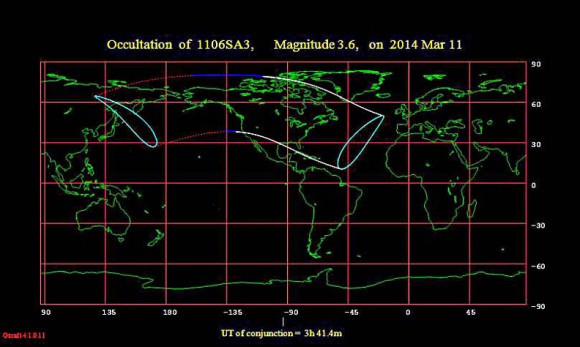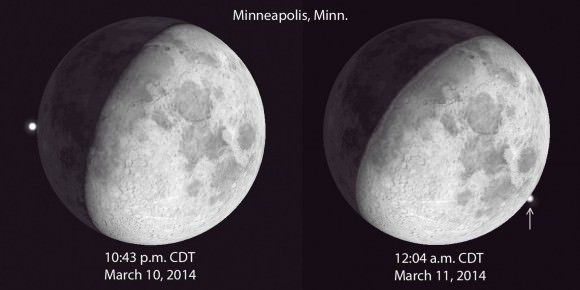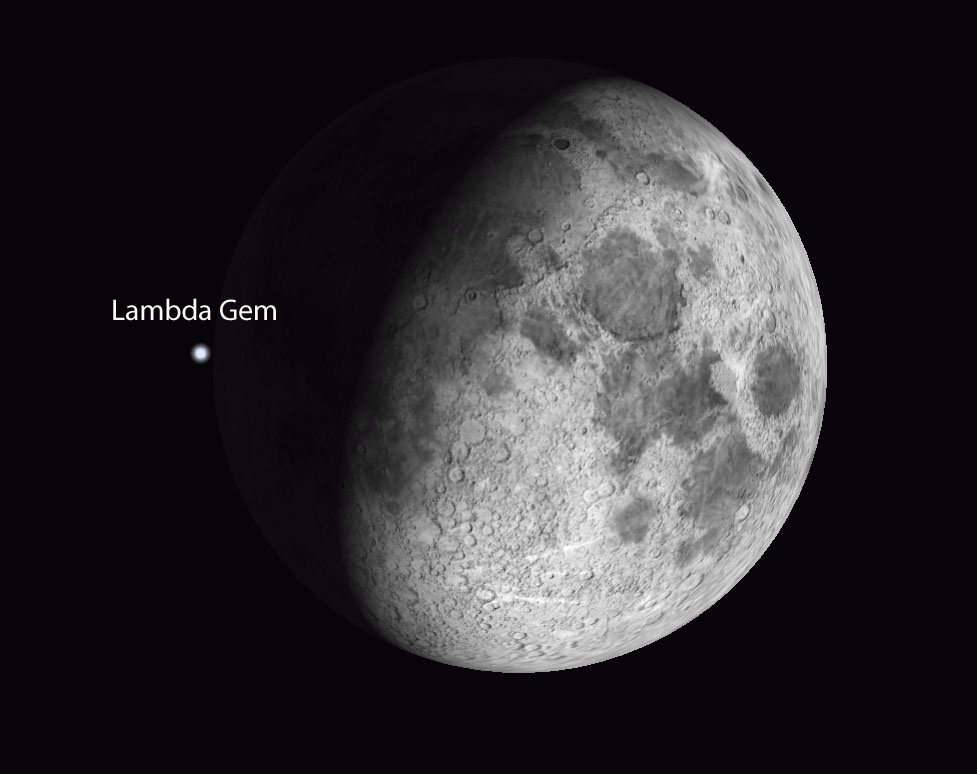Ever dabbled in the occult? You’ll have your chance Monday night March 10 when the waxing gibbous moon glides in front of the star Lambda Geminorum for much of North America, occulting it from view for an hour or more. Occultations of stars by the moon happens regularly but most go unnoticed by casual skywatchers. Lambda is an exception because it’s one of the brighter stars that happens to lie along the moon’s path. Shining at magnitude +3.6, any small telescope and even a pair of 10×50 or larger binoculars will show it disappear along the dark edge of the moon.

With a telescope you can comfortably watch the star creep up to the moon’s edge and better anticipate the moment of its disappearance. The fun starts a few minutes before the impending black out when the moon, speeding along its orbit at some 2,280 mph (3,700 km/hr), draws very close to the star. During the final minute, Lambda may seem to hover forever at the moon’s invisible dark limb, and then – PFFFT – it’s gone! Whether you’re looking through telescope or binoculars, the star will blink out with surprising suddenness because the moon lacks an atmosphere.

If there was air up there, Lambda would gradually dim and disappear. Even without special instruments, early astronomers could be certain the moon had little if anything to protect it from the vacuum of space by observing occultations.
As the moon moves approximately its own diameter in an hour, you can watch Lambda re-emerge along the bright limb roughly an hour later, though its return will lack the drama and contrast of a dark limb disappearance. While occultations allow us to see how swiftly the moon moves in real time as well as provide information on its atmosphere or lack thereof, real science can be done, too.
Planets also are occasionally occulted by the moon. Time lapse of Venus’ disappearance on May 16, 2010
Observers along the occultation boundary in the southern U.S. can watch the star pop in and out of view as it’s alternately covered and uncovered by lunar peaks jutting from the moon’s limb. Before spacecraft thoroughly mapped the moon, careful timings made during these “grazing occultations” helped astronomers refine the profile of the moon’s limb as well as determine elevations of peaks and crater walls in polar regions. They can still be useful for refining a star’s position and motion in the sky.
The moon’s limb can also be used much like a doctor’s scalpel to split unsuspected double stars that otherwise can’t be resolved by direct observations. Take Lambda Gem for instance. We’ve known for a long time that it totes around a magnitude +10.7 companion star 10 arc seconds to its north-northeast, but previous occultations of the star have revealed an additional companion only a few hundredths of an arc second away orbiting the bright Lambda primary. The star plays a game of hide-and-seek, visible during some occultations but not others. Estimated by some as one magnitude fainter than Lambda, keep an eye out for it Monday night in the instant after Lambda goes into hiding.
Lunar occultation and reappearance of Antares Oct. 21, 2009
I watched just such a “two-step” disappearance of Antares and it fainter companion some years back. With brilliant Antares briefly out of view behind the moon’s limb, I easily spotted its magnitude +5.4 companion just 2.5 arc seconds away – an otherwise very difficult feat at my northern latitude.
Want to know more about things that disappear (and reappear) in the night? Make a visit to the International Occultation Timing Association’s website where you’ll find lists of upcoming events, software and how to contribute your observations. If you’re game for Monday night’s occultation, click HERE for a list of cities and times. Remember that the time show is Universal or Greenwich Time. Subtract 4 hours for Eastern Daylight, 5 for Central, 6 for Mountain and 7 for Pacific. Wishing you clear skies as always!


Hmmm.. Wonder is it possible to find exoplanets during the occultation, if they are occulted after the star itself. The earthlike world 1 a.e. out would be 26th magnitude, and occulted about 30 milliseconds after the star, but in some more favorable cases this might work…
I’ll try to catch this event! I guess I have underestimated what can be done with Stellarium? Thanks for bringing that up Bob. I’ll look more closely at that program now…. I’ve had it on this computer for a couple years but have apparently not gone into it deeply enough? Any tips not in the help menu?